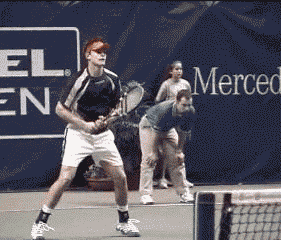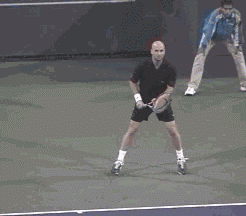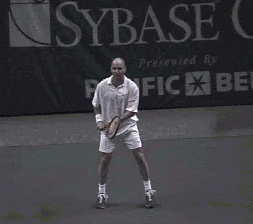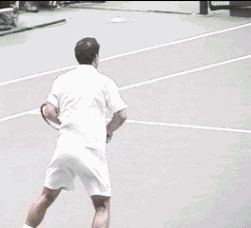|
TennisOne Lessons
It's the same in tennis. When learning, you want to keep the ball in play and in the court. The less you have to remember, the easier it will be for you to get a feel for it. That is exactly how the top pros play, thinking as little as possible. They focus on the feel of the ball with a simple, uncomplicated technique which they found to work at some time in their career. And yes, you can learn to play tennis quickly. It is actually an easy sport to learn - but only if you know the correct technique. We Are All IndividualsTake a look at how the top pros hit and move around the court. Does Andre Agassi copy Pete Sampras serve? Should Pete copy Andre's groundstrokes? Does Venus move like Serena or the other way around? Why do Capriati and Hingis differ in their set up and takeback? Are you molded like someone else or do you have your own traits?
The answer is simple. Each one of these wonderful players, as well as yourself, is a different person, with individual moves, balance, and feel. They all generate their strokes and power in a different way. However they approach the ball in their own idiosyncratic fashion, the one basic thing they have in common is that they all find the ball before exploding into it! Call it the athlete's instinct, a natural gift. It is nothing else than total absorption on getting the racquet on the moving ball. Each of these pros moves differently, executes strokes with their own grace and at their own pace. There aren't two exact duplicates. Each one is a master in his/her own way. And so are you! Keep things simple. Don't try to override things that you've learned at a very tender age. Focus only on what you are doing with your hand and the ball, while the rest your body is coordinated in an instinctive way you probably learned before you were five years old. Conventional teaching techniques, on the contrary, draw your attention to many distractions. They point to the position of your feet, body, and weight balance. They give you mental images to follow which may differ drastically from the hand-eye coordination you learned as a child. For instance, the part most often tampered with is the backswing, the part of the swing prior to contact with the ball. Most tennis teachers consider it a separate part of the swing and something you must control consciously. But look at the top professionals. You'll see they all have different ways of taking the racquet back. The backswing is their own personal way of "finding" the ball, while generating power at the same time.
The Five EssentialsSo how can you play like the pros? What is their secret - the key that elevates them so high? The power of simplicity! The essential basics are timing, speed, balance, power, and lots of space to hit. But there are barriers to learning such simple stuff, extraneous and arbitrary additions that interfere with the body's natural movement and turn your game upside down. The secret of great timing is to take your time. Don't fill your time with numerous distractions while you're waiting for the ball. In short, don't think too much because if you do, it will seem as if you have no time at all and the ball will mysteriously fly by your racquet without making solid contact. The secret of great speed? Run after the ball like you would run after your dog or your child. Don't waste time preparing your shot before you take off on the run. And don't take several side-steps or run in a peculiar way. The secret of good balance? Listen to your body, it will tell you whether you are leaning too little or too much, or stopping too hard. The secret of power: Use your body's natural movement, like turning at the waist and then uncoiling it, at the precise time. It is not taking the racquet back early and running uncomfortably. Just think of power prior to hitting, and the body will respond in the most efficient way.
The secret of feeling that there is a lot of room to place the ball: The answer is ball rotation, topspin, which lets you clear the net higher and still bring the ball down safely. This factor has been underestimated and only recent research has clearly shown the intensity of the top players roll. Top pros like Agassi and Venus Williams have an average topspin above 1500 RPM. (To check on the ball rotation of top players, go to John Yandell's Advanced Tennis Research Project.) The secret of confidence: Finding the ball and knowing where to finish your swing. So what is the downfall of most conventional tennis teaching methods? Number one: Idiosyncrasies get no respect. Your potential as an athlete, or even as a normal person, is immediately placed in doubt. You are told you need to take your racquet back as soon as you see the ball coming your way, to take some side steps instead of facing the way you run, to put this foot here to hit, step into the ball and transfer your weight this other way, to follow the ball with your racquet as if you were playing baseball, you are discouraged by the teacher to make the ball roll, and on and on and on. Imagine a player who has to turn his left shoulder and still sidestep to the ball. His coordination is shut down, his feel is anywhere else but in his hands, he wonders why he is almost falling and why the ball is so hard to find. If he is a beginner, he won't be long in the sport. As a child, you knew how to get around gracefully; smoothly, fluidly, a symphony of coordinated moves. You didn't have to think about it and you don't have to think about it now. Yet suddenly you are in the hands of an expert and you are urged to follow all the "musts." Add to that a racquet and a moving ball and the body becomes paralyzed - unable to respond naturally.
The success ratio of those standard, conventional instructions has been found, by the tennis teaching profession no less, to be below 20%. It was blamed on the premise that tennis is "a difficult sport to learn", and that "few people are coordinated enough to learn it well." The "natural way," on the other hand, has over a 90% success rate. People rally back and forth within a couple of hours from their start. They thrive in "the simplicity" of the sport. And what is the "natural way?" Put simply, be yourself, learn the basics, and develop your game in the most natural way. Use the gift of your own instincts. The most efficient stroking techniques are very simple and are now being applied by many teachers and students in over one hundred and fifty countries around the world. Overall, get the ball in the court. That is the purpose of the game.
From 1982 through 1990 he promoted the same techniques to a large tennis academy for kids in Florianopolis, Brazil, helping coach Guga Kuerten until he was fourteen. From 1991 through 1995 he taught weekly on the New Tennis Magazine Show/ Tennis Television with Brad Holbrook, and, by Richard Williams own admission "made so much sense that he adopted them to coach Venus and Serena". From 1994 through 2000 Wegner worked for ESPN Latin America and for PSN, commenting on Wimbledon, the French and Australian Opens, ATP and WTA tournaments, and the Davis Cup. Oscar is currently in Clearwater, Florida, where he is developing a grass roots "Tennis is Easy" campaign through radio and his website academy, tennisteacher.com
|
Last Updated 11/15/01. To contact us, please email to: webmaster@tennisone.com TennisONE is a registered trademark of TennisONE and SportsWeb ONE; Copyright 1995. All rights reserved. |
||||||||






 Oscar
Wegner began his quest to introduce his breakthrough teaching techniques
in the National Tennis School in Barcelona, Spain, in 1973. He encouraged
the coaches and players to follow the topspin style of Spanish great
Manuel Santana, two-time Grand Slam winner Rod Laver, Jack Kramer and Bill
Tilden among other former champions. Oscar's teachings included a natural
open stance on the forehand and swinging across the body, rather than
following the path of the ball.
Oscar
Wegner began his quest to introduce his breakthrough teaching techniques
in the National Tennis School in Barcelona, Spain, in 1973. He encouraged
the coaches and players to follow the topspin style of Spanish great
Manuel Santana, two-time Grand Slam winner Rod Laver, Jack Kramer and Bill
Tilden among other former champions. Oscar's teachings included a natural
open stance on the forehand and swinging across the body, rather than
following the path of the ball.